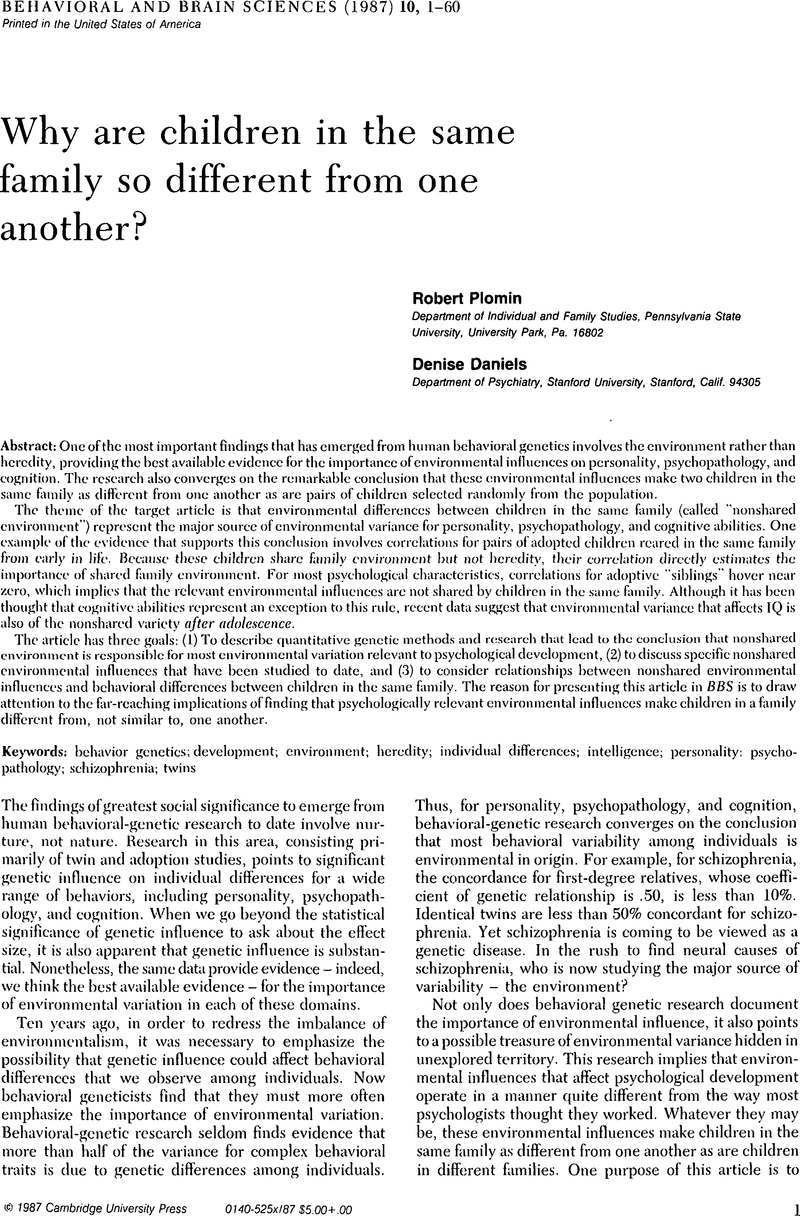Crossref Citations
This article has been cited by the following publications. This list is generated based on data provided by Crossref.
Dudley, R. M.
1991.
Why are adoptees so similar in IQ?.
Behavioral and Brain Sciences,
Vol. 14,
Issue. 2,
p.
336.
Caspi, Avshalom
1991.
Cleaning up the environment.
Behavioral and Brain Sciences,
Vol. 14,
Issue. 3,
p.
391.
Socha, Radomír
1991.
Problems with the “environment as phenotype” hypothesis.
Behavioral and Brain Sciences,
Vol. 14,
Issue. 3,
p.
407.
Thelen, Esther
1991.
Improvisations on the behavioral-genetics theme.
Behavioral and Brain Sciences,
Vol. 14,
Issue. 3,
p.
409.
Plomin, Robert
and
Bergeman, C. S.
1991.
The nature of nurture: Genetic influence on “environmental” measures.
Behavioral and Brain Sciences,
Vol. 14,
Issue. 3,
p.
373.
Rowe, David C.
1991.
Three shocks to socialization research.
Behavioral and Brain Sciences,
Vol. 14,
Issue. 3,
p.
401.
Hirsch, Jerry
1991.
Obfuscation of interaction.
Behavioral and Brain Sciences,
Vol. 14,
Issue. 3,
p.
397.
Scarr, Sandra
1991.
The construction of family reality.
Behavioral and Brain Sciences,
Vol. 14,
Issue. 3,
p.
403.
Boomsma, Dorret I.
and
Molenaar, Peter C. M.
1991.
Implications for behavior genetics research: No shared environment left?.
Behavioral and Brain Sciences,
Vol. 14,
Issue. 3,
p.
389.
Johnson, Ronald C.
1991.
Genes and environment: A complicated affair.
Behavioral and Brain Sciences,
Vol. 14,
Issue. 3,
p.
398.
Rutter, Michael
1991.
Origins of nurture: It is not just effects on measures and it is not just effects of nature.
Behavioral and Brain Sciences,
Vol. 14,
Issue. 3,
p.
402.
Schönemann, Peter H.
and
Schönemann, Roberta D.
1991.
We wondered where the errors went.
Behavioral and Brain Sciences,
Vol. 14,
Issue. 3,
p.
404.
Plomin, Robert
1991.
Why children in the same family are so different from one another.
Behavioral and Brain Sciences,
Vol. 14,
Issue. 2,
p.
336.
Bradley, Robert H.
and
Caldwell, Bettye M.
1991.
Like images refracted: A view from the interactionist perspective.
Behavioral and Brain Sciences,
Vol. 14,
Issue. 3,
p.
389.
Graham, Philip
1991.
Genetic explanations of environment explain little.
Behavioral and Brain Sciences,
Vol. 14,
Issue. 3,
p.
395.
McGue, Matt
Bouchard, Thomas J.
Lykken, David T.
and
Finkel, Deborah
1991.
On genes, environment, and experience.
Behavioral and Brain Sciences,
Vol. 14,
Issue. 3,
p.
400.
Hay, David A.
1991.
“Significant and substantial” or minor and unreliable genetic influences on measures of the environment?.
Behavioral and Brain Sciences,
Vol. 14,
Issue. 3,
p.
396.
Simonton, Dean Keith
1991.
Genes and genius from Galton to Freud.
Behavioral and Brain Sciences,
Vol. 14,
Issue. 3,
p.
406.
Plomin, Robert
and
Bergeman, C. S.
1991.
Nature and nurture.
Behavioral and Brain Sciences,
Vol. 14,
Issue. 3,
p.
414.
Bronfenbrenner, Urie
1991.
The nurture of nature.
Behavioral and Brain Sciences,
Vol. 14,
Issue. 3,
p.
390.



